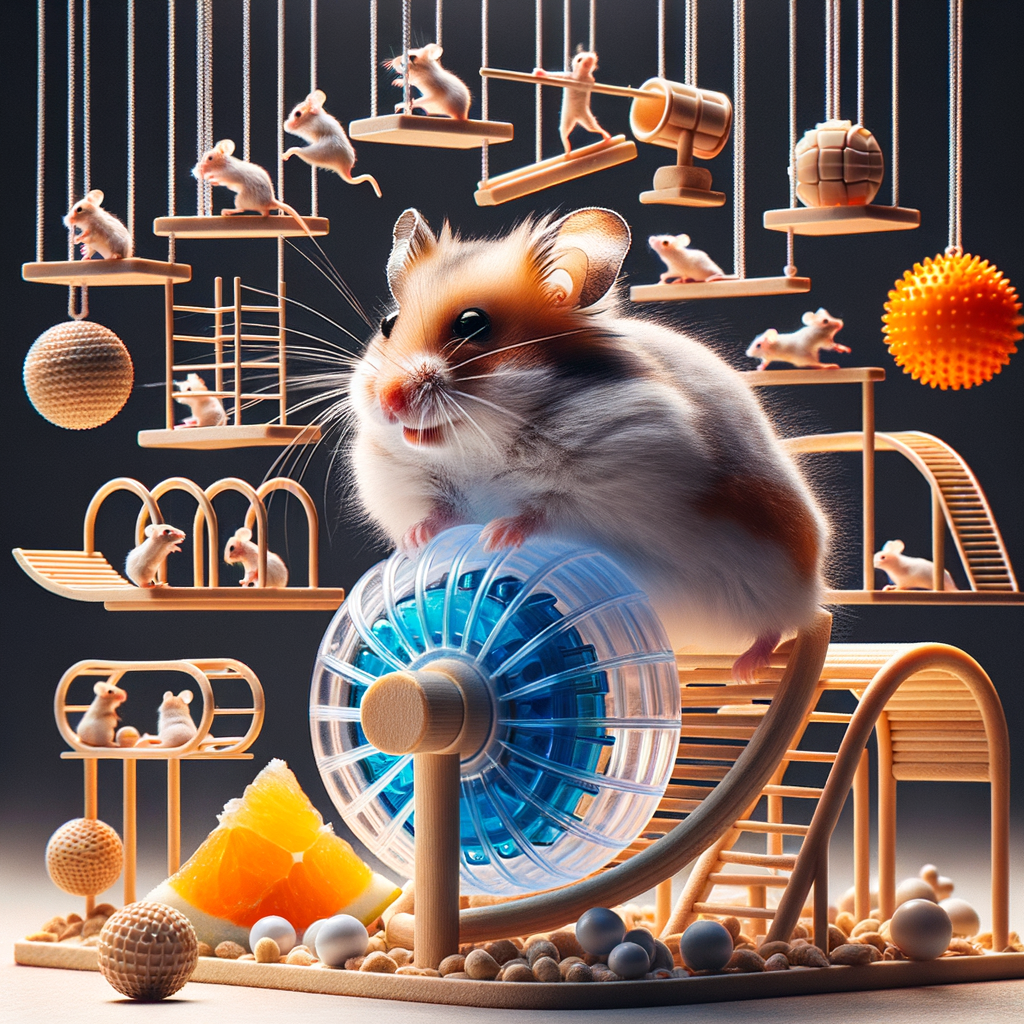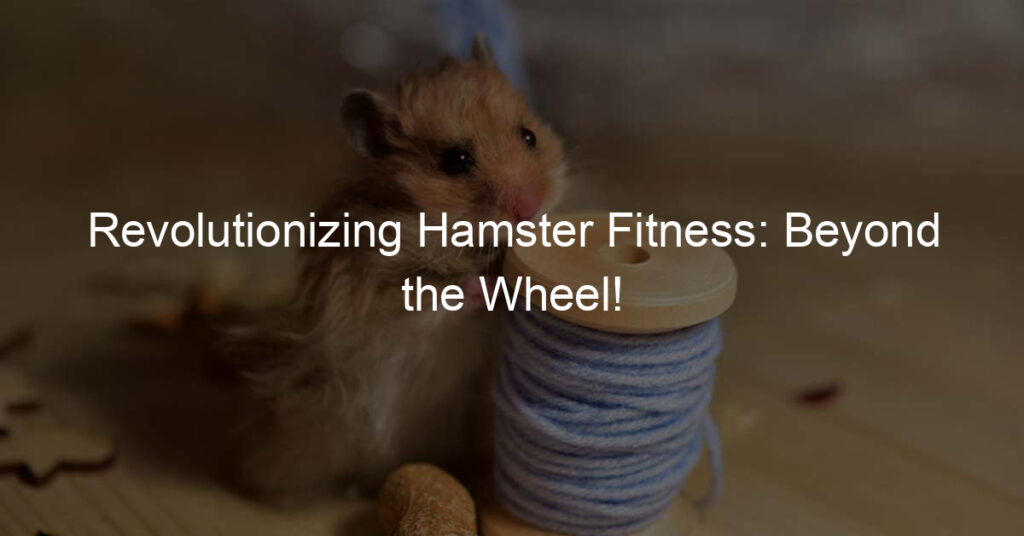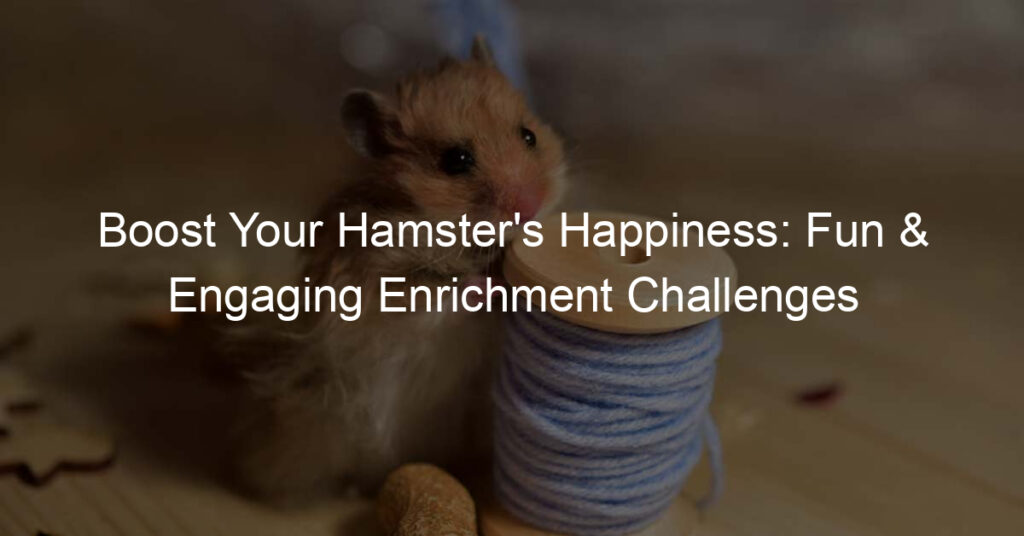
Introduction to Hamster Fitness
Hamsters are small, adorable creatures that make wonderful pets. Just like humans, they also need regular exercise to stay healthy and happy. This article will explore the importance of exercise for hamsters and dispel some common misconceptions about hamster exercise.
- The Importance of Exercise for Hamsters
- Common Misconceptions About Hamster Exercise
Exercise is crucial for a hamster’s overall health. It helps them maintain a healthy weight, keeps their heart strong, and even improves their mood. Without enough exercise, hamsters can become overweight, which can lead to various health problems like heart disease and diabetes. Exercise also helps hamsters to burn off energy and reduce boredom, which can prevent destructive behaviors.
There are several misconceptions about hamster exercise. One common myth is that hamsters don’t need much exercise because they’re small. However, in the wild, hamsters are very active and can travel several miles in a single night. Therefore, pet hamsters also need plenty of exercise to mimic their natural behavior.
Another misconception is that running on a wheel is the only exercise a hamster needs. While running wheels are a great way for hamsters to get exercise, they also enjoy other activities like climbing, burrowing, and exploring. Providing a variety of exercise options can help keep your hamster engaged and healthy.
Traditional Hamster Exercise Options
When it comes to keeping your hamster fit and healthy, there are several traditional exercise options available. One of the most popular and effective options is the hamster wheel.
Hamster Wheel
The hamster wheel is a classic exercise tool that has been used by hamster owners for many years. It provides a simple and convenient way for your hamster to burn off energy and stay fit. Let’s delve into the benefits and potential drawbacks of the hamster wheel.
- Benefits of the Hamster Wheel
- Potential Drawbacks of the Hamster Wheel
There are several benefits to using a hamster wheel for your pet’s exercise. Firstly, it allows your hamster to run and play at any time, day or night, without needing your supervision. This is particularly beneficial as hamsters are nocturnal creatures and are most active during the night.
Secondly, using a hamster wheel can help prevent obesity in your pet, which is a common health issue in hamsters. Regular exercise on the wheel can help maintain a healthy weight and reduce the risk of related health problems.
Lastly, the hamster wheel can also contribute to your pet’s mental well-being. Regular physical activity can help reduce stress and boredom, leading to a happier and healthier hamster.
Despite its many benefits, there are a few potential drawbacks to using a hamster wheel. One of the main concerns is the risk of injury. If the wheel is not the correct size or if your hamster runs too fast, it could potentially fall out and hurt itself.
Another potential drawback is the noise. Hamster wheels can sometimes be quite noisy, especially if your hamster likes to run on it during the night. This could potentially disturb your sleep or the sleep of other family members.
Lastly, while the hamster wheel provides a good source of exercise, it should not be the only form of activity for your pet. Hamsters also need time to explore and play outside of their cage to stay mentally stimulated.
Hamster Ball
Another traditional exercise option for your hamster is the hamster ball. This is a plastic, transparent ball that your hamster can roll around in. It’s a fun and engaging way for your hamster to get some exercise. However, like any other exercise equipment, it’s important to use it safely and understand its pros and cons.
- How to safely use a hamster ball
- Ensure the ball is the right size for your hamster. It should be large enough for your hamster to move around comfortably.
- Always supervise your hamster while it’s in the ball. Never leave it unattended.
- Limit the time your hamster spends in the ball. A maximum of 15-20 minutes is recommended.
- Make sure the area where your hamster will be rolling around is safe. It should be free of stairs, sharp objects, and other pets.
- Pros and cons of the hamster ball
Using a hamster ball safely is crucial to ensure your hamster’s well-being. Here are some steps you can follow:
Like any exercise equipment, the hamster ball has its advantages and disadvantages.
| Pros | Cons |
|---|---|
| Provides a change of scenery for your hamster | Can be stressful if used for long periods |
| Allows your hamster to explore safely | Can be dangerous if not supervised |
| Helps your hamster burn off energy | Not suitable for all hamsters |
It’s important to weigh these pros and cons before deciding to use a hamster ball. Always prioritize your hamster’s safety and comfort.
Alternative Hamster Workouts
When it comes to keeping your hamster healthy and happy, exercise is key. But who says exercise has to be boring? Let’s explore some fun, non-traditional ways to get your hamster moving!
Non-Traditional Hamster Exercise
While running wheels and balls are common ways for hamsters to exercise, there are other exciting options that can provide both physical activity and mental stimulation. Here are three alternative exercises for your hamster:
- Hamster Agility Courses
- Hamster Swimming
- Hamster Climbing Toys
Just like dogs, hamsters can enjoy agility courses too! You can create a simple course at home using safe household items. This not only helps your hamster stay fit but also sharpens their problem-solving skills. Remember, always supervise your hamster during these exercises to ensure their safety.
Did you know that hamsters can swim? Introducing your hamster to water in a shallow, controlled environment can be a great way to help them exercise. However, it’s important to note that not all hamsters enjoy water, so always monitor their reactions closely.
Climbing is a natural activity for hamsters. Providing them with safe climbing toys can help them exercise while having fun. From simple ladders to complex climbing frames, there’s a wide range of options available.
These non-traditional exercises can add variety to your hamster’s workout routine, making it more enjoyable for them and helping to keep them healthy and active.
| Exercise Type | Benefits |
|---|---|
| Hamster Agility Courses | Improves physical fitness and problem-solving skills |
| Hamster Swimming | Provides a unique form of exercise, but always monitor your hamster’s reactions |
| Hamster Climbing Toys | Offers a natural and fun way for hamsters to exercise |
Remember, every hamster is unique and may prefer different types of exercise. It’s important to observe your hamster and adjust their exercise routine according to their preferences and abilities.
Hamster Wheel Alternatives
While the traditional hamster wheel is a common sight in many hamster habitats, there are other exciting alternatives available. These options not only provide physical exercise but also stimulate your hamster’s mental faculties. Let’s explore two of these alternatives: the hamster seesaw and the hamster maze.
- Hamster Seesaw
The hamster seesaw is a fun and engaging alternative to the traditional hamster wheel. It’s a simple device, much like the seesaws we see in children’s playgrounds, but designed to be safe and suitable for hamsters. When your hamster walks onto one end of the seesaw, it tips, providing a fun, rolling motion that hamsters seem to enjoy. This toy not only provides physical exercise but also helps to keep your hamster mentally stimulated.
- Hamster Maze
A hamster maze is another fantastic alternative to the hamster wheel. This toy provides a complex network of tunnels and chambers for your hamster to explore. It’s a great way to keep your hamster physically active and mentally engaged. You can even hide treats in the maze to motivate your hamster and make the exploration even more exciting. Hamster mazes come in various sizes and complexity levels, so you can choose one that best suits your hamster’s abilities and interests.
In conclusion, while the hamster wheel is a tried-and-true exercise device, it’s not the only option. The hamster seesaw and hamster maze are just two of the many alternatives that can provide your hamster with the physical exercise and mental stimulation it needs. So why not try something new and see how your hamster likes it?
Innovative Hamster Exercise Ideas
When it comes to keeping your hamster fit and active, there are many innovative ideas that you can try. These ideas not only provide your hamster with the necessary exercise but also stimulate their minds, keeping them engaged and happy. Here are some of the most innovative hamster exercise ideas:
- Interactive Hamster Toys
- DIY Hamster Exercise Equipment
Interactive toys are a great way to keep your hamster entertained and active. These toys are designed to engage your hamster’s natural instincts and curiosity, encouraging them to explore and play. For example, puzzle toys with hidden treats inside can keep your hamster busy for hours as they try to figure out how to get to the treat. Similarly, toys that move or make sounds can stimulate your hamster’s senses and encourage them to investigate.
If you’re feeling creative, you can even make your own hamster exercise equipment. This not only allows you to customize the equipment to suit your hamster’s needs and preferences but also provides a fun and rewarding project for you. For instance, you can create a hamster wheel from a plastic container or a climbing frame from wooden dowels. Just make sure that any DIY equipment is safe for your hamster to use, with no sharp edges or small parts that could be swallowed.
Remember, the key to a healthy and happy hamster is a combination of a balanced diet, regular exercise, and mental stimulation. By providing your hamster with a variety of exercise options, you can ensure they stay fit and active, while also keeping them entertained and engaged.
Case Studies: Unique Hamster Exercise
Let’s delve into some unique hamster exercise methods that have been tried and tested. We will look at two case studies to understand the design, setup, and results of these innovative workouts.
Case Study 1: Hamster Agility Course
The first case study we will explore is the Hamster Agility Course. This is a unique exercise method that involves creating a mini obstacle course for your hamster. It’s not just fun for the hamster but also a great way to keep them active and healthy.
- Design and setup
- Results and observations
The agility course was designed with a variety of obstacles, including small ramps, tunnels, and hurdles. The setup was created using safe, non-toxic materials to ensure the hamster’s safety. The course was designed to challenge the hamster’s agility and stimulate their curiosity.
The hamster showed a significant increase in activity levels after using the agility course. It was observed that the hamster was more active, alert, and showed signs of improved health. The hamster also displayed an increased interest in exploring its surroundings, indicating mental stimulation. The agility course proved to be a successful method of providing both physical exercise and mental stimulation for the hamster.
In conclusion, the Hamster Agility Course is an effective and enjoyable way to ensure your hamster gets the exercise it needs. It’s not just about physical activity, but also about providing mental stimulation and encouraging natural behaviors. This case study shows that with a little creativity, we can create unique and effective exercise methods for our hamsters.
Case Study 2: Hamster Swimming
Swimming is not a traditional exercise for hamsters, but it can provide a unique and engaging workout. In this case study, we’ll explore the preparation and safety measures taken, as well as the outcomes and findings of this unconventional exercise method.
- Preparation and Safety Measures
- Outcomes and Findings
Ensuring the safety of our furry friends is paramount. Before introducing a hamster to water, we made sure the water was shallow enough for the hamster to touch the bottom. The water temperature was kept at a comfortable level, similar to room temperature, to prevent the hamster from getting too cold.
We also ensured a safe and easy exit from the water was available at all times. A small ramp was placed in the water, allowing the hamster to climb out whenever it wanted. Constant supervision was maintained throughout the exercise session to ensure the hamster’s safety.
Our hamster participants showed a surprising level of adaptability to the water. Initially, they were hesitant, but with time, they started moving around in the water, using their legs to paddle. The swimming exercise proved to be a good workout, as it engaged multiple muscle groups.
However, it’s important to note that not all hamsters enjoyed the experience. Some showed signs of stress, such as rapid breathing and trying to escape. These hamsters were immediately removed from the water.
Overall, swimming can be a beneficial exercise for hamsters, but it’s not suitable for all. Always prioritize your hamster’s comfort and safety, and closely monitor their behavior during the exercise.
| Preparation Measures | Findings |
|---|---|
| Shallow, room-temperature water | Most hamsters adapted to the water |
| Easy exit from the water | Some hamsters showed signs of stress |
| Constant supervision | Swimming engaged multiple muscle groups |
Conclusion: Different Ways to Exercise Hamsters
As we reach the end of our discussion on hamster fitness, it’s essential to revisit the key points and understand the importance of variety in hamster exercise. Let’s take a moment to recap and reflect on the innovative ways to revolutionize hamster fitness.
- Recap of alternative hamster workouts
- Importance of variety in hamster exercise
- Final thoughts on revolutionizing hamster fitness
We’ve explored a variety of alternative hamster workouts, from hamster yoga to mini obstacle courses. These exercises not only provide physical benefits but also stimulate your hamster’s mind, keeping them active and engaged. For instance, hamster yoga involves a series of stretches and poses that help improve flexibility and balance. On the other hand, mini obstacle courses challenge your hamster’s agility and problem-solving skills.
Variety in exercise is crucial for your hamster’s overall health and wellbeing. Just like humans, hamsters can get bored with the same routine. Introducing new and exciting workouts can keep your hamster motivated and eager to exercise. A diverse exercise regimen also ensures that your hamster works out different muscle groups, promoting balanced development and preventing potential injuries.
Revolutionizing hamster fitness is about thinking outside the box and creating a fun, stimulating environment for your hamster. It’s about understanding your hamster’s needs and tailoring workouts that cater to their unique characteristics. With the right approach, we can transform the way we think about hamster exercise and pave the way for happier, healthier hamsters.
In conclusion, hamster fitness is an exciting field with endless possibilities. By embracing alternative workouts and understanding the importance of variety, we can revolutionize the way we approach hamster exercise. Remember, a fit hamster is a happy hamster!








